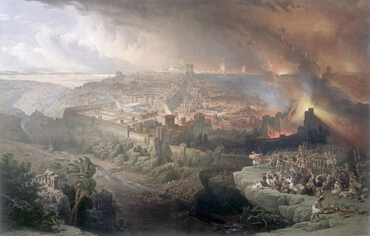1
Jis šaukė garsiu balsu: “Ateikite, sprendimo miestui vykdytojai! Kiekvienas atsineškite naikinimo įrankį!”
2
Atėjo šeši vyrai nuo šiaurės aukštutinių vartų. Kiekvienas atsinešė naikinimo įrankį; tarp jų buvo vyras, apsivilkęs drobiniais. Jis laikė dešinėje rankoje rašymo priemones. Atėję jie sustojo prie varinio aukuro.
3
Izraelio Dievo šlovė pasitraukė nuo cherubo, ant kurio ji būdavo, prie šventyklos slenksčio. Jis šaukė drobiniais apsivilkusiam, kuris turėjo rašymo priemonių:
4
“Pereik Jeruzalės miesto viduriu ir paženklink kaktoje tuos žmones, kurie dejuoja ir šaukia dėl mieste daromų bjaurysčių”.
5
Kitiems, man girdint, Jis įsakė: “Eikite paskui jį ir žudykite! Nesigailėkite nieko.
6
Žudykite senius, jaunuolius, mergaites, vaikus ir moteris, bet nelieskite turinčių ženklą. Pradėkite nuo mano šventyklos!” Jie pradėjo nuo vyresniųjų, buvusių prie šventyklos.
7
Jis jiems dar įsakė: “Sutepkite šventyklą, pripildykite kiemus užmuštų. Pradėkite!” Jie ėjo ir žudė mieste esančius.
8
Kai jie juos žudė, aš, likęs vienas, kritau veidu į žemę ir šaukiau: “Viešpatie Dieve, argi sunaikinsi Izraelio likutį, išliedamas savo rūstybę ant Jeruzalės?”
9
Jis atsakė: “Izraelio ir Judo nusikaltimas yra labai didelis; kraštas ir miestas pilnas nekalto kraujo ir pasileidimo. Jie sako: ‘Viešpats paliko žemę ir nemato mūsų’.
10
Todėl Aš nesigailėsiu jų ir nebūsiu jiems nuolaidus. Aš jų kelius sugrąžinsiu jiems patiems”.
11
Vyras, apsirengęs drobiniais, laikantis rašymo priemones, pranešė: “Padariau, kaip įsakei”.







